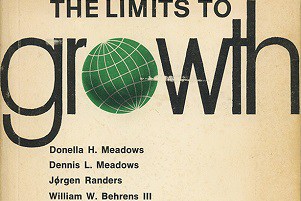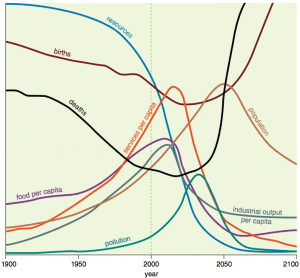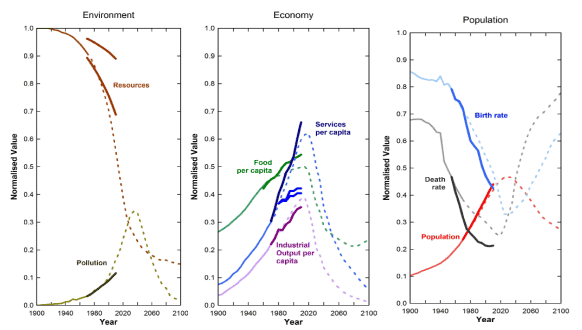The Club of Rome was founded in 1968 but really came into the public eye with the publication of Limits to Growth in 1972. The controversial book, which sold 12 million copies in 37 languages, first called attention to the systemic limitations of the exponential expansion of the human population and the related material inputs and waste outputs of its economic system on a planet that is fixed in scale.
The concept is not complicated. Sooner or later, the endless expansion of the metabolism of a system within a finite body will cease.
Critics and the media misinterpreted (or willfully distorted) the message at the time as a prediction of imminent collapse. The authors were accused of being neo-Malthusian alarmists, personally attacked, and dismissed. If there were any doubt about that dismissive conclusion it was reinforced in the following decade of the eighties, during which deregulation ushered in an era of seemingly boundless prosperity. The authors were quacks; their systems dynamics models were wrong; there are no limits to growth — end of discussion.
One problem: Turns out reality is tracking the modelers’ “business as usual” case remarkably closely.
Several recent studies, the most prominent one by Australian physicist Graham Turner, have validated the basic accuracy of the systemic interconnections the original study highlighted forty-two years ago. We are tracking the “business as usual” scenario quite well, given the limitations of these early systems models in 1972. Critically, we are just now approaching the moment of truth with respect to the economic indicators that the models anticipated, as the charts below demonstrate. Furthermore, as Turner explores, it is possible that the 2008 financial collapse, and the ongoing economic malaise, may actually be linked to the looming tipping point around 2015 that the “business as usual” scenario indicated back in 1972.
And most importantly, we have wasted four decades ignoring the insights of the original Club of Rome report, leaving us in a state of global emergency that is becoming harder to ignore, with warning signs flashing red, most notably the effects of global warming. (See Johan Rockstrom’s “Planetary Boundaries: Exploring the Safe Operating Space for Humanity“)
This is the context in which Club of Rome Co-Chairs Anders Wijkman and Ernst von Weizsaecker convened the annual meeting of the Club of Rome in Mexico City last week. The theme of the conference was the energy transition off fossil fuels, which juxtaposed nicely against Mexico’s new commitment to clean up corruption in Pemex, the State-owned oil company, while also welcoming (and this is where it became surreal but also very poignant) new foreign direct investment, previously banned, into exploration partnerships with Pemex in order to accelerate fossil fuel extraction with the goal of reversing the State’s declining oil revenues.
This is exactly the tension underlying what I call our “$20 Trillion Big Choice.” While we focus as we must on the monumental challenge to mobilize the necessary policies and investments to transition the world off fossil fuels, those sitting on our existing stock of fossil fuel reserves, from Exxon to Mexico, are naturally seeking to optimize the exploitation of those reserves, which remain highly profitable as long as we continue to ignore the costs of global warming. And the $20 trillion “choice” is harder. It means not only ceasing to invest new capital to expand fossil fuel extraction – $674 billion last year alone – it means writing off some $20 trillion of existing proved reserves (“stranded assets”) rather than cashing them in (as a comparison, the direct financial losses of the subprime crisis in the U.S. were a mere $2.7 trillion).
The divestment movement now well underway is focused primarily on the 25 percent of this stranded asset issue owned by public companies. (See Rockefeller Brothers Fund historic decision to divest.) Exxon, the successor company to John D. Rockefeller’s Standard Oil, has responded to the Rockefeller decision with a statement about their concern for those facing energy poverty.Touching.
But the real question is the largest and most complex geopolitical challenge of all time: how can we restrain the exploitation of existing proved fossil fuel reserves, not only those controlled by the Exxon’s of the world, but even more difficult, the 75 percent of reserves controlled by nation states like Mexico (and Saudi Arabia, Iraq, Iran, Venezuela, Canada, and Russia just for starters) whose economies (and social cohesion) are currently highly dependent upon the continued sale of oil and gas?
I was privileged to address the attendees at the Annual Meeting on “Financing the Energy Transition.” In my speech, I addressed three interconnected monumental challenges:
- Mobilizing the estimated $44 trillion (that’s Trillion with a “T”) of investment required between now and 2050 for renewable energy technologies and critical energy efficiency, (see the International Energy Agency’s recent report);
- The $20 trillion stranded asset challenge referred to above; and
- The overarching context of limits to growth, which implies a corollary limits to investment a challenge no economic system has ever had to contemplate.
Jane Jacobs once said, “it’s not how big you grow, it’s how you grow big.”
As we reflect on the prescience of the Club of Rome’s seminal work on limits to growth, nothing could be more important at this pivotal moment in time. Future growth and development, beginning with the energy system that fuels it, and the business models that define its qualities, will need to evolve as living systems have done over billions of years, to more intricate, regenerative systems.
Watch for the Club of Rome’s next act, shifting from prescient diagnosis to a search for genuine solutions, rooted in a systemic level understanding of the forces at play. We can say for sure that there are limits to mindless growth. Regenerative economies nurture mindful growth and development. This is the future we had better embrace.
—
To read John’s full address to attendees of the Annual Conference of the Club of Rome, click here.




